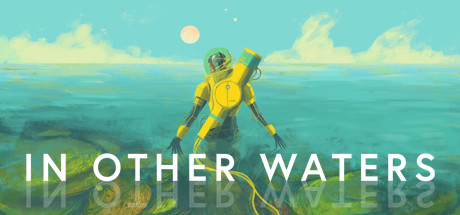In Other Waters does a relaxing take on an aquatic exploration. Explore the planet to study new specimens through the simplistic interface.
Type: Single-player
Genre: Adventure
Developer: Jump Over The Age
Publisher: Fellow Traveller
Release date: 3 Apr, 2020


Intro
In Other Waters takes you to a planet far from Earth, where you meet a xenobiologist who is trying to find a lifeform and reconcile with her friend. Deep dive into a planet full of water to find specimens and study them.
Visuals
In Other Waters provides a simplistic design. It plays out from a top-down view, where you can see everything through a radar-like interface. Although the simplistic UI looks neat after you get used to it, it is confusing for first-timers to operate. There is no information on what each button does and you need to do a trial end error to figure out what they do.
Story
Despite the story being one of the main focuses of the game, the design seems to encourage you to skip it. There is no hotkey to advance the dialogue, although it will do it automatically after some time has passed. It takes too much time to do it manually when you have nothing better to do, while it can be problematic to read when you need to do a lot of actions in a short time. The best that you can do is to read everything through the message log, which I always did most of the time, not only because of how the dialogue advances, but also because the story tends to be hard to understand unless if you read the whole paragraph at once.
If you are interested in reading alien lives, the game has a lot to offer. You’ll study different specimens, tracking your discovery in your journal. This journal takes form in a full report of the specimens’ behavior, images, and theories of the xenobiologist. However, since they all are non-fiction, I don’t find any benefit in reading them, especially since they have a lot of texts.

The Game
Gameplay
As I said before, the game takes form in a radar-like interface where you can scan the area and order the protagonist, Ellery Vas, to move around. However, the game barely has tutorials to understand how it works, and figuring out how to walk took more time than it should be. Moreover, the interface seems to encourage you to do everything with your mouse, despite it will be easier to play with a keyboard. Fortunately, keyboard shortcuts for some actions like scanning an area and moving forward are available, which help to cut time in exploration.
As a xenobiologist, you also can research the specimens on this watery planet. This can be done by taking samples of the specimens in certain spots and bring them back to the lab to do more experiments. You’ll bound to get extras from the sample gathering, and these can be used either as a fuel or as a tool to manipulate your environment. Some specimens can be used to clear obstacles in a short area while others can help you to provide an O2 area in poisonous areas.

Although the specimens will be more focused on environment manipulation at the start, you’ll explore more dangerous areas as you progress. Your engine and O2 supplies will deteriorate faster than they should be, and you must use extra specimens as fuel to keep going. This also makes the end-game areas to be a chaotic mess, forcing you to rush the areas before you run out of fuels. Standing still is discouraged, whether it’s to read the story dialogues or the small texts that are always available on every node in your path.
Length and Difficulty
I finished the game in ~6h after collecting all specimens. Some specimens are only available in optional areas, forcing you to re-explore previous areas and remember the areas that you haven’t explored to find them. This also means that it’s best to explore an area in one sitting, especially since you need to visualize the rough map of the area to prevent yourself from getting lost. The difficulty is easy as long as you focus on exploration and not spending your time reading the texts too much in the dangerous areas.

Problems
The game doesn’t mark the next objective at one point near the end of the game. The UI is also not intuitive when it notifies a diveable area. I got stuck in the game twice because of these problems. You also can’t check the previously collected specimens when you are exploring an area, and the limited amount of specimens that you can carry at once might prevent you from progressing too much to prevent the use of non-duplicate specimens in the process.
Specs
Intel Core i5-9300H 2.40GHz, 8GB RAM, NVIDIA GeForce GTX 1650
Verdict
Being a relaxing game that is focused on exploration, it feels boring at first – you only need to scan the area and move around on repeat. It started to get better once the path branches out, letting you explore more areas and find rare specimens at the end of the road. Despite it being hard to read the story in dangerous areas, it does a good job in killing the boredom, forcing you to finish the task quickly. However, people who had a hard time visualizing a map on their heads might have difficulty with the game, especially since some areas tend to look similar. At the end of the day, it’s still a nice relaxing game, one that will be enjoyed for those who like to explore.










